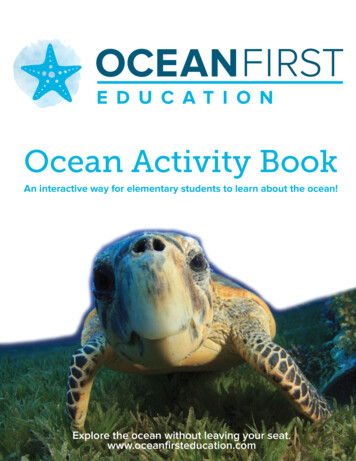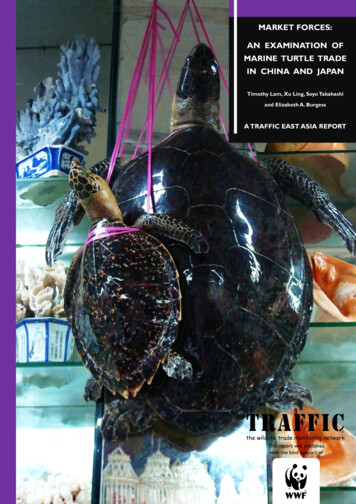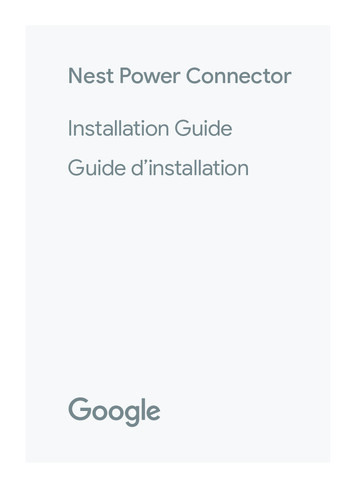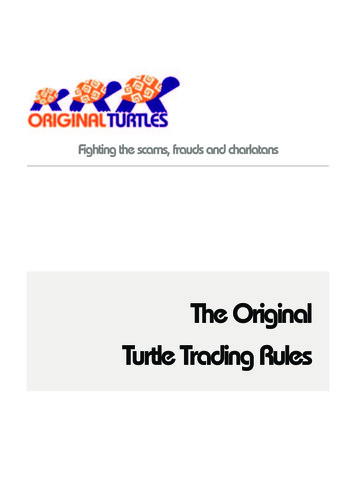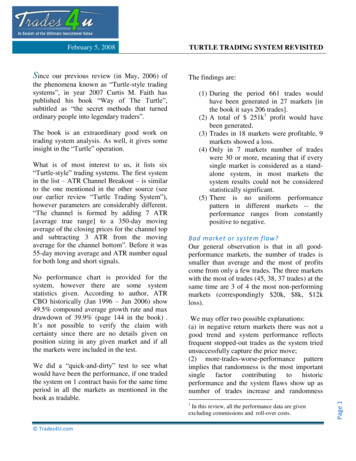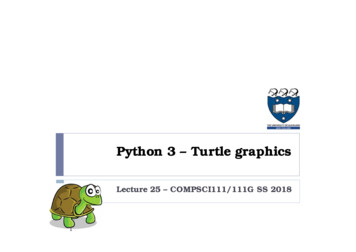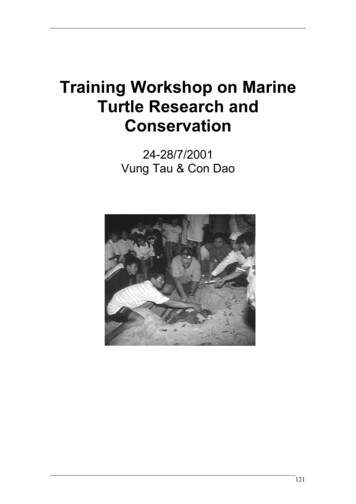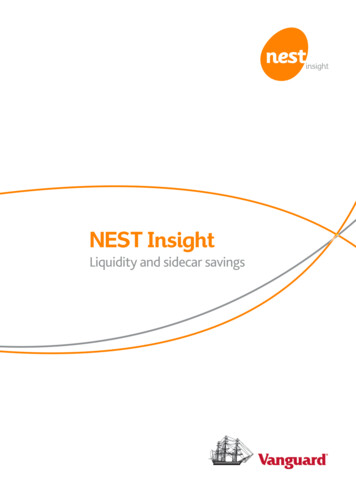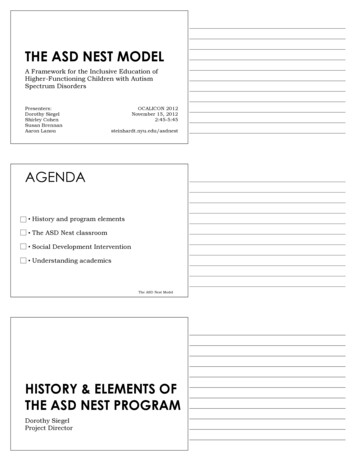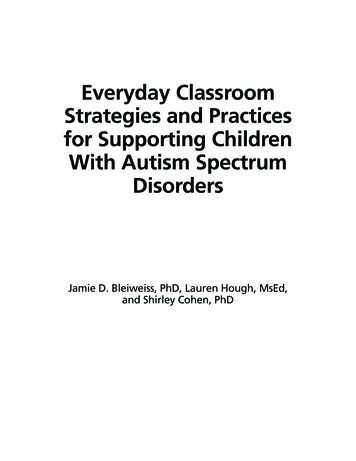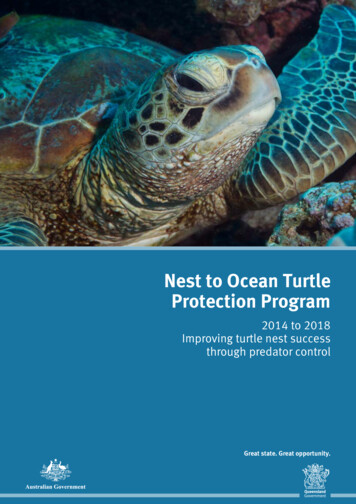
Transcription
Nest to Ocean TurtleProtection Program2014 to 2018Improving turtle nest successthrough predator controlGreat state. Great opportunity.1
Cover image: ‘Turtle 3’ courtesy of Tourism and Events QueenslandPrepared by: Queensland Parks and Wildlife Service, Department of National Parks, Recreation, Sport and Racing State of Queensland, 2014.The Queensland Government supports and encourages the dissemination and exchange of its information. The copyright in thispublication is licensed under a Creative Commons Attribution 3.0 Australia (CC BY) licence. Under this licence you are free, withouthaving to seek our permission, to use this publication in accordance with the licence terms.You must keep intact the copyright notice and attribute the State of Queensland as the source of the publication.For more information on this licence, visit .enAugust 2014#30621 - Design and AV Services, Corporate Communications, NPRSR EHP2
ContentsBackground. 4Issues. 4Objectives. 5Scope. 5What types of projects will be supported?. 6Partners. 7Timing . 7Funding available. 8References. 93
BackgroundThe Queensland coast is home to some of the most important marine turtle nestingand feeding sites in the world. Six species of threatened turtles nest along our idyllicbeaches. Even in settled areas, many beaches are regularly used by nesting turtles.Despite the integrity of our nesting beaches there has been a severe global decline ofsea turtle populations, and of the seven species found in the world, three are classifiedby the United Nations as Endangered, and three as Critically Endangered under bothCommonwealth and State threatened species listing.Feral pig stomach contents, including numerousflatback turtles, Jardine River, CYP.Image courtesy of Tim Kerlin and J Lee, AQIS, 2006.The Nest to Ocean Turtle Protection Program will focus on the commitment made bythe Commonwealth and Queensland governments to protect marine turtle eggs andhatchlings from predation by feral pigs and other predators. The Department of NationalParks, Recreation, Sport and Racing’s Queensland Parks and Wildlife Service (QPWS)will lead delivery of this 7 million program over four years in close collaboration withthe Commonwealth Department of the Environment and other partner agencies.The Queensland Parks and Wildlife Service manages over 12.5 million hectares of landand seven million hectares of marine park. Many areas support active nesting of turtlesand the Service carries out active predator control in a number of key turtle nestingareas along the east coast. A range of other groups and organisations is also engagedin turtle conservation works around the state and this program will supplement andcomplement existing projects to deliver improved turtle conservation outcomes.This program will also aim to develop collaborative partnerships across governmentsand the community to enhance the incubation success of turtle eggs in Queenslandthrough active predator control and other nest protection measures.IssuesAustralia supports globally significantbreeding populations of green, loggerhead,hawksbill, flatback and olive ridley turtles.Unfortunately, many of these populationsare in decline.From the time they are laid as eggs, turtlesface many threats including: predation of eggs and hatchlings byferal and native animalsA number of existing community groupand government entities fund on-groundpest management focussed on theconservation of ecosystems, includingstate agencies, such as the QueenslandParks and Wildlife Service and theDepartment of Environment and HeritageProtection and community groupssuch as natural resource managementorganisations and Indigenous organisations. marine debrisIn North Queensland, feral pig controlactivities are targeting green, hawksbill,oliver ridley and flatback turtle rookeries onEastern and Western Cape York Peninsulaand in the Gulf of Carpentaria. On thesouthern coast, fox control activities arehelping marine turtle nesting success onthe mainland along the Burnett Coast fromnorth of Agnes Water to the Queenslandborder where loggerhead, green, flatbackand leatherback turtles nest. environmental factors andnest disturbance fisheries by-catchEgg predationpigs, dogs, foxes, goannas, food harvesting for subsistence useacross their range hatchling disorientation through alteredlight horizons at nesting beachesHatchling predation deteriorating water qualitypigs, dogs, foxes, goannas, birds,fish, sharks, beach crabs, crocodiles loss of habitat.Feral animal predation of turtle eggs andhatchlings is one of the main threatsfacing marine turtle populations inQueensland and is the main focus ofthe Nest to Ocean Turtle ProtectionProgram. Data on egg predation is limited.However, two studies conducted onwestern Cape York showed feral pigs wereresponsible for the loss of up to 70% ofclutches of eggs on many beaches.Immature and adult lossmarine debris/ghost nets, hunting,international harvest, pollutionEnvironmental impactshatchling disorientation,sea level changesFigure 1: interrelated impacts on turtle populations.4
ObjectivesThis program is aimed at increasing the survivability of marine turtle clutches of eggsand hatchlings by enhancing existing programs and exploring innovative ideas for feralpig and other predator controls. The overall program objectives are to: Increase survivability of marine turtle clutches of eggs and hatchlings. Reduce feral predation impacts on marine turtle rookeries. Provide proactive nest protection and feral animal control actions at all identifiedpriority rookeries during nesting seasons. Enhance and augment existing Traditional Owner and local community engagementand participation in turtle nest protection and predator control. Explore innovative ideas for predator control.Turtle hatchlings heading to the sea.Image courtesy of Tourism and Events Queensland Ensure strategic investments and enduring legacy outcomes are derived fromthe investment.ScopeKey marine turtle rookeries along thecoast and on offshore islands will beidentified and prioritised for active nestprotection and predator control efforts.Annual implementation plans andmonitoring programs will be developed forthe priority sites.Coastal ZonesWestern Cape York and Gulf of CarpentariaEastern Cape YorkBamagaRockhampton to BrisbaneWeipaThe Recovery Plan for Marine Turtles inAustralia (Commonwealth of Australia2003), the draft Recovery Plan for MarineTurtles in Australia (in prep.) and Feral PigThreat Abatement Plan (Commonwealthof Australia 2005), will inform the scopeof the program, including identificationof existing or easy-start programs thatcan be enhanced and augmented. Due tothe geographic scale of this program, thestate will be divided into a series of fourzones or program areas to focus deliveryof outcomes and methods accordingto the factors and characteristics of theindividual zone.Within each zone or priority area it isexpected that a number of discreteprojects may be implemented.!LockhartRiver!!Aurukun!Eastern Cape YorkWestern Cape Yorkand Gulf of ktownMareeba !CairnsNN OO RR TT HH EE RR NNTT EE RR RR II TT OO RR YYSome priority sites may include urbanareas and some may be quite remote,some will be on existing national parksand other protected areas and some willnot. The location and type of threats in thearea will determine the kind of treatmentsto be deployed. Identification of strategicinvestments and lasting legacy outcomesare in the scope of the program.Townsville to !CloncurryRichmond!!Home !BowenHillTownsville to ach!Barcaldine!Emerald! Blackwater!RockhamptonGladstoneRockhamptonto Hervey Bay!!Birdsville!Charleville!Roma!Gympie!Kingaroy Nambour!Dalby!SS OO UU TT HHAA UU SS TT RR AA LL II AA!Cunnamulla!St horpe!Murwillumbah!GoldWarwick !Coast!BallinaCasinoNN EEWW AAWSS OWO UU TT HHLL EE SSFigure 2: Turtle protection program implementation zones5!!!
What types of projects will be supported?The types of projects the program will consider include control options that use a combination of ground and aerial shooting, groundand aerial baiting and installation of nest protection devices at strategic locations. The focus of all operations will be on critical egglaying and hatching times. Protection and control methods will usually be determined by the location and proximity to populationcentres and will be integrated to achieve the most effective predator reduction:Projects and activities thatenhance or augment existingwork undertaken or underwaywhere appropriateProjects will ideally be based on workthat has established information onnature and extent of impact of predatorson turtles and the stakeholders involvedin addressing the problem.Ideally, projects must leave an enduringlegacy in the impact area rather than replaceexisting projects. Projects must identify howthey add value to existing or previous workthat has been undertaken to manage feralpigs and other predators of turtles.Projects and activities thatdo not undermine or replaceexisting activityRoutine feral pig and other predator controlsare not supported. Projects should clearlyidentify the types of existing activitiesthat are being undertaken, as well asapproaches that will prevent a reduction inexisting activity to manage feral animals. Inother words the program aims to augmentand enhance existing projects and activitiesin controlling feral pig predation on turtles.New projects and activities thatidentify priority areasWhile projects should build on existingwork, if some priority areas are identifiedthat are currently not being activelymanaged, project proposals will beaccepted. New projects must provideclear detail on how they would meet theprogram objectives.Projects that have flexibility toamend actions depending onseasonal conditionProjects and activities thatidentify the entity with thecapacity to deliverIn certain seasonal conditions certaincontrol techniques may have to bemodified or deferred. Projects mustinclude a contingency plan for use inthe event of seasonal impacts.Projects that are developed on a zonebasis with identified activities areencouraged. One entity may oversee theproject but delivery may be by a varietyof entities. It is important that the projectclearly identifies the on-ground deliveryactivities and funding allocations torespective entities.Projects that reflect adaptivebest-practice managementProjects will need to identify thecombination of techniques, targetspecificity, areas of application, and timeof year and build on available informationfor actions to achieve cost effective control.Projects and activities thatreflect group managementrather than individualmanagement are preferredTo maximise investment and to helpfacilitate coordination and integration ofcomplementary feral animal managementprograms, it is preferred that, wherepossible, landscape-scale projectswill be undertaken.Organisations such as regional naturalresource management groups and localIndigenous land and sea managementgroups will develop projects throughconsultation with affected stakeholders.This can include state and local governmentlevels, regional natural resource managementgroups, land and sea management groupsand private sector project proponent orproponents. It will be necessary that consentof land owners is obtained before any onground works are undertaken.6Projects that incorporatemonitoring of resultsPriority areas will be identified usingexisting knowledge and, where gaps areidentified, surveys can be conductedto evaluate priority areas. In all casesmonitoring of activity and project resultsmust be included.
PartnersTimingA multi-agency Steering Committeecomprising representatives of key Stateand Commonwealth departments hasbeen formed to provide executive decisionmaking and governance guidance tothe program. In conjunction with thiscommittee, turtle, pig and predator expertswill provide advice on a range of detailedtechnical matters. Local working groupsmay be formed to coordinate, plan andprovide operational implementation ofcontrol actions.There will be times of active nest protection through predator exclusion devices andon-ground baiting and shooting of feral animals. These times will be based on turtlenesting and feral animal breeding cycles (where known) to ensure number of survivingnesting sites is maximised.The Queensland Parks and Wildlife Servicewill establish a joint monitoring programin collaboration with the Department ofEnvironment and Heritage Protection (EHP).This will include measuring and reviewingthe effectiveness and outcomes of theprogram and help identify significant turtlerookeries likely to be impacted by feralanimals, to guide priorities and coordinatethe distribution of funding.Effective communication and coordinationbetween this program and existingprograms and initiatives in Indigenous landand sea management will be important.Figure 3: Graph showing known turtle nesting season East Coast(Limpus, 1985) and anecdotal evidence of seasonal feral pigbreeding times in Central and North Queensland.The engagement of contractors andcommercial providers can be accommodatedin project proposals for the program.Figure 4: Graph showing impacts of culling feral predators leadingup to turtle nesting season that increases hatchling survivability(Limpus, 1985).A feral pig digging up a turtle nest.Image courtesy of Jim Mitchell, DNRM, 2004.7
Funding availableThe Commonwealth and Queensland governments have each committed matchingfunds of up to 3.5 million over the next four years to help reduce the threat of feralpredation on marine turtle nests.There will initially be two rounds of funding; the first round will target existing activitiesand projects closing Monday 6 October 2014, and a second round will highlight scope forinnovation and development open from November 2014. The guidelines for applicants willbe available for the first round of applications for the 2014/15 turtle nesting season.The first round will target existing programs and projects. Applications can be madeelectronically to turtles.partnerships@nprsr.qld.gov.au .New turtle hatchlingImage courtesy of Tourism and Events Queensland8
References1. Limpus, C. J., Reed, P. C. and Miller, J. D. (1985). Temperature dependent sex determination in Queensland sea turtles: intraspecificvariation in Caretta caretta. In ‘Biology of Australasian Frogs and Reptiles.’ (Eds. G. Grigg, R. Shine and H. Ehmann) Pp. 343–351.(Royal Zoological Society: New South Wales.)2. Whytlaw, P, Edwards, W & Congdon, B. 2013. Marine turtle nest predation by feral pigs (Sus scrofa) on the western Cape YorkPeninsula, Australia: Implications for management. Wildlife Research 40, 377-384.3. Commonwealth of Australia, 2003. Recovery Plan for Marine Turtles in Australia.4. Commonwealth of Australia, 2014 (in Prep) Recovery Plan for Marine Turtles in Australia5. Commonwealth of Australia, 2005. Threat Abatement Plan Feral Pigs.9
10
Created Date: 9/5/2014 4:31:59 PM Title: Nest to Ocean Turtle Protection Program 2014 to 2018 - Improving turtle nest success through predator control
